Lava River Cave
in Newberry National Volcanic Monument

Lava River Cave is the longest lava tube in Oregon and is fascinating to explore. Put fresh batteries in your flashlights and head to Newberry National Volcanic Monument, which is in Deschutes National Forest just a dozen miles south of Bend. Walking through Lava River Cave, you will see wild features left behind by volcanic eruptions 100,000 years ago. After a mile in the dark, venture back to the surface to complete a unique underground hike.
Leave the parking area and walk up to a ranger station at the top of Lava River Cave Trail. Check in, rent a lantern if you need one, and begin down the paved path. The trail makes a horseshoe bend to the right and eases down between walls of volcanic rocks. After less than a tenth of a mile, reach a metal staircase plunging into a dark cave. If you are wondering how lava tubes form during volcanic eruptions, a park sign explains that:
Flowing lava cools quickly and a hard, rock shell forms on all exposed surfaces. Inside, molten lava stays a comfortably searing 2,100°F (1,150°C). Cooling rock eventually confines liquid lava to a narrow pipeline. When the volcanic eruption ends – lava drains out leaving an empty tube.
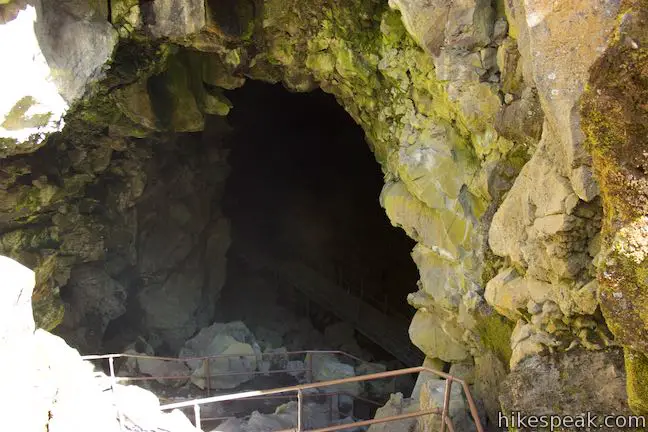
Most of the “trail” in Lava River Cave is on easy (though uneven) surfaces on the floor of the Lava tube. The terrain is roughest near the entrance of the cave, where a couple breakdowns block easy travel. At this end of the tube, large sections of the roof of the cave have collapsed, placing obstacles on the bottom of the cave. Metal walkways and staircases take you over the roughest stuff, but you will need to maneuver some boulders to make your way into the cave.
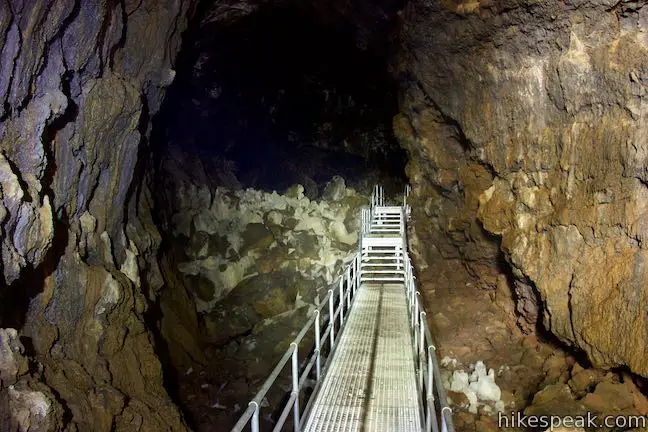
At the base of the first flight of stairs, a level gangway leads to a few stairs going up to an area of rough rocks. When Lava River Cave opens for the season (in May), you might discover ice formations near the mouth of the cave. The natural light pouring into the cave disappears as you go up the next steps, putting you very much in the dark to cross the hike’s roughest terrain. Feel your way to a longer staircase that drops to a deep spot in the cave. Below these steps, the ground of the cave is level and easy to walk across. Ascend one more long metal staircase over a breakdown to find solid ground again. From here, the floor of Lava River Cave is easy to cross and metal walkways are no longer needed.
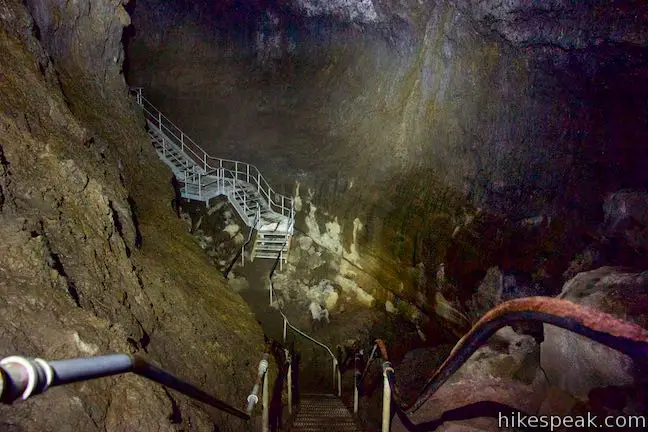
The floor of the cave is smooth and somewhat sandy, thanks to sediments that drop through cracks in the roof of the cave to create an easy walking surface. As you venture deeper into the cave, examine the walls around you. Evidence of the lava that flowed through the tube hangs from the walls and the glazed ceiling, offering clues about the lava that passed through the tube during different eruptions.
The cave is very, very dark and can feel claustrophobic. Try turning off your flashlights to see how black the lava tube gets. As you proceed to the back of Lava River Cave, you will pass a few named highlights like the Highway Crossing, Tube in a Tube, and Sand Gardens.
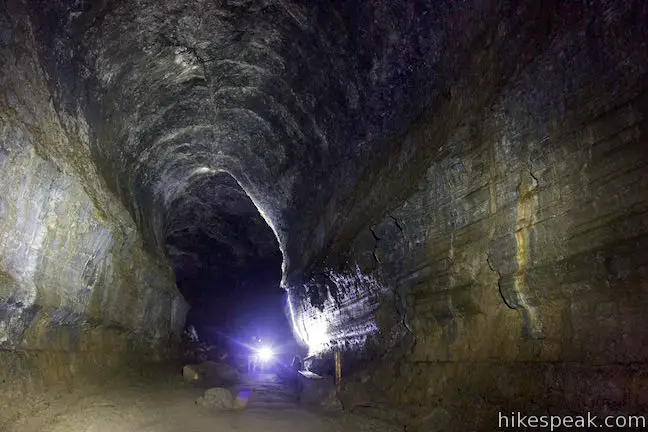
Hike through an area of the cave called Echo Hall that is fifty feet across with a ceiling more that 50 feet tall. About a third of the way into the cave, find a bench and a sign marking the highway crossing. No, you won’t need to look both ways to cross Route 97 because the highway is far above you. At this point in Lava River Cave, the ceiling is over 30 feet tall, topped by another 50 feet of rock between the cave and the surfance. You won’t even hear the passing traffic. The sign highlights the flow lines and lava shelves in this part of the cave:
“Bathtub rings” or flow lines form when lava maintains a constant level and deposits a ridge of Lava on the wall. The more prominent ridge is called a Lava shelf and has lavacicles (lava stalactites) on its underside due to re-melting of the tub surface. A thin glassy glaze, wrinkled glass, and other re-melt features are abundant in the cave.
You’ll find flow lines in other parts of the cave as well. The Highway Crossing Area has high ceilings and feels quite grand. Some stretches of the cave that lie ahead have ceilings that are just five feet tall. You will reach a low ceiling area named Low Bridge Lane about 1,500 feet from the cave entrance.
Continue deeper into the cave to the third checkpoint, “Tube in Tube.” Here the lava flow formed a vertically stacked passage, a smaller channel within the large tube. When lava levels decreased late in an eruption cycle, the lava only flowed through the lower, smaller tube. Arches of hardened lava separate the passage that you walk through from a larger chamber above.
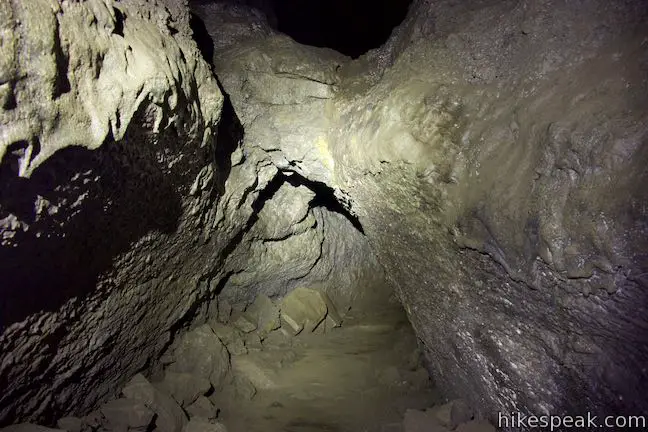
The roof shortens as you walk farther into the deep, dark cave. Eventually, you’ll arrive at the Sand Gardens, a special area on the right side of the lava tube with sand castle-like mounds. A fence encloses the Sand Gardens to protect these fanciful creations. A panel explains how the garden was planted:
Sediment washed slowly through roof cracks and partially filled the cave, especially in the lower section. The delicate “sand garden” or “fairy castles” form as water droplets erode the sand fill.
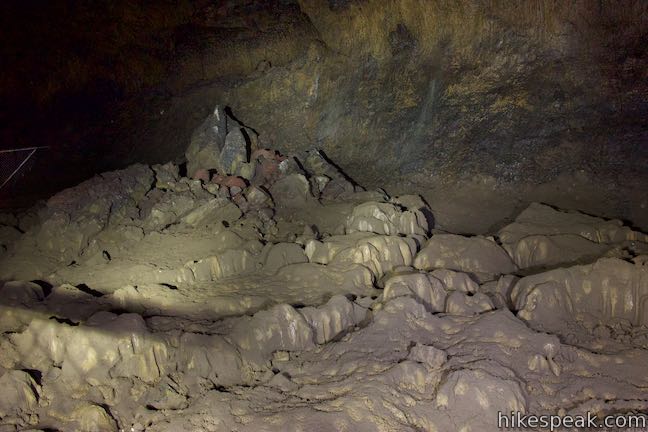
Sand from the surface drips into Lava River Cave a few grains at a time and eventually makes its way through small cracks in the floor. The Sand Gardens are the final major attraction in Lava River Cave. Ahead the roof shrinks again and you will come to a white sign near the end of the cave. Hikers are asked to turn back here. The sign reads:
Do not enter. The area behind this sign is closed due to safety hazards and sensitive resources. Rangers are on patrol. You are at the end of Lava River Cave. Only a short crawl section remains. The area behind this sign is closed due to injuries and mishaps in prior years and concerns with potential white-nose syndrome contamination. Thank you for respecting this closure. Enjoy the cave on your way back out!
Beyond the sign, the back of the cave becomes filled in by sand, so you probably aren’t missing anything. Walk back the way you came, seeing all the attractions in the cave for a second time. This is a one-way dead end cave, so it’s impossible to take a wrong turn. Lava River Cave is one of Oregon’s longest (if not the longest) un-collapsed lava tubes, measuring 5466 feet, so give yourself plenty of time to explore its dark passages. This hike is approximately 2.2 miles round trip with 150 feet of elevation change and takes around 90 minutes to complete.
Looking for another lava tube? While almost all of the other hikes on hikespeak.com are above ground, you may also enjoy checking out Ape Cave in Washington.
Costs: A national forest day use fee is required to visit Lava River Cave, which is $5 per day. A Northwest Forest Pass or America the Beautiful public lands pass can be used in place of the day use fee. The cave is dark and does not have any park-provided lighting. You must carry your own light sources (bring at least two). If you forget to bring flashlights, lanterns can be rented for $5 (before 4 p.m.) at the start of Lava River Cave Trail.
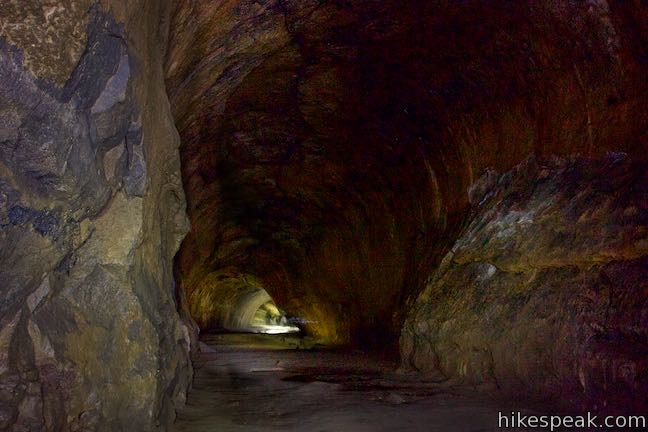
Hours of Operation: Lava River Cave is open from May through September and is closed during the rest of the year (helping to protect the cave’s bat population). In May, Lava River Cave is open Thursday through Monday from 10 a.m. to 5 p.m. From Memorial Day Weekend to Labor Day Weekend, the cave is open daily from 9 a.m. to 5 p.m. Later in September, the cave is open daily from 10 a.m. to 5 p.m. Don’t come after 4 p.m. if you want to see the cave. To secure a parking spot, the national forest recommends that you arrive before 11 a.m. on busy days.
Restrictions: Due to concerns over white-nose syndrome, which is killing bat populations, do not enter the cave with anything that has been in another cave in the last two years (like your boots and clothing). Dress warmly. Temperatures in the cave stay in the 40s and you will likely get dripped on. Because of the low ceilings, child carrier backpacks are not recommended. Use the bathrooms by the parking area before entering the cave because you won’t find any underground. Naturally, dogs and bikes are not allowed in Lava River Cave.
Directions to Lava River Cave: From Bend, travel south on US 97 for 11 miles. Take the Crowford Road Exit, following a sign for Lava Lands Visitor Center and Benham Falls Trailhead. At the end of the offramp, drive straight past a road into the visitor center on the right and turn left onto Cottonwood Road. Cross under US 97, drive one mile, and turn right into the parking area for Lava River Cave, finding the cave entrance on the left.
Coming from Sunriver, take US 97 north to exit 151. At the bottom of the offramp, turn right on Cottonwood Road and drive 0.8 miles to the Lava River Cave Day Use Area, which will be on the left.
When you leave the cave, drive south to get back on US 97 at exit 151.
Trailhead address: Lava River Cave, Cottonwood Road, Bend, OR 97707
Trailhead coordinates: 43.8954, -121.3696 (43° 53′ 43.44″N 121° 22′ 10.56″W)
Use this map to view the trail and get directions:
Or view Oregon trails and campgrounds in a larger map
 | Lava Butte This hike explores a cinder cone with a fire lookout tower and a crater-circling trail that offer panoramic views over Lava Butte Lava Flow and the Cascade Mountains. |
 | Trail of the Molten Land This 1.1-mile long paved partial loop cuts through Lava Butte Lave Flow and is packed with information and views. |
 | Trail of the Whispering Pines This interpretive botanical trail explores high desert plants on the edge of Lava Butte Lava Flow on a quarter-mile long path. |
 | Deschutes River Trail to Benham Falls This 1.9-mile hike follows a leisurely trail along the Deschutes River to aggressive cascades called Benham Falls where the river churns and tumbles through a gap between cliffs. |
 | Tumalo Falls See Bend’s best waterfall on a short walk to a downstream viewpoint or a half-mile round trip hike to an overlook by the top of the falls. |
 | Tumalo Falls Loop This 7.4-mile circuit ventures above Tumalo Falls and explores numerous other waterfalls and cascades on Tumalo Creek, combining North Fork Trail, Swampy Lakes Trail, and Bridge Creek Trail. |
 | Pilot Butte This 1.8-mile hike ventures up the dominant landmark in Bend to offer sweeping views of the majestic surroundings. |
 | Archie Briggs Canyon Trail This 1.25-mile hike descends a ravine to clifftop views over a dramatic canyon on the Deschutes River. |
 | Shevlin Loop Trail This 4.75-mile tour of Shevlin Park just a few miles east of Bend explores pine forests on both sides of Tumalo Creek. |
 | More trails in Oregon Explore other hikes in Central Oregon, the Columbia River Gorge, and elsewhere. |
 | Ape Cave in Mount Saint Helens National Volcanic Monument (Washington) This adventurous underground hike travels through one of the longest lava tubes in the world. |
 | Trail of Two Forests in Mount Saint Helens National Volcanic Monument (Washington) This short nature trail tours a landscaped that was transformed by a molten lava flow. For extra fun, crawl through a 50-foot long lava tube beneath the trail. |
 | Guler Ice Cave in Gifford Pinchot National Forest (Washington) This short hike goes underground to explore an old lava tube with frozen stalactites and stalagmites, plus other interesting cave features. |
 | Kalahuipua‘a Trail and Fishponds Loop (Hawaii) This action-packed 1.7-mile hike explores a lava field with a lava tube shelter and impressive fishponds along a gorgeous coastline. |
 | Kaumana Caves (Hawaii) This underground hike explores lava tubes on the edge of Hilo, created by an 1881 eruption of Mauna Loa. |
 | Lava Tube in Mojave National Preserve (California) This short 0.6-mile hike drops below the desert surface into an old lava tube with a spectacular skylight. |
 | Caves Trail in Crates of the Moon National Monument (Idaho) This 1.6 mile travels above and below the surface, exploring lava tubes in the Great Rift Lava Flow. |








































How many steps are there in total to reach the floor?